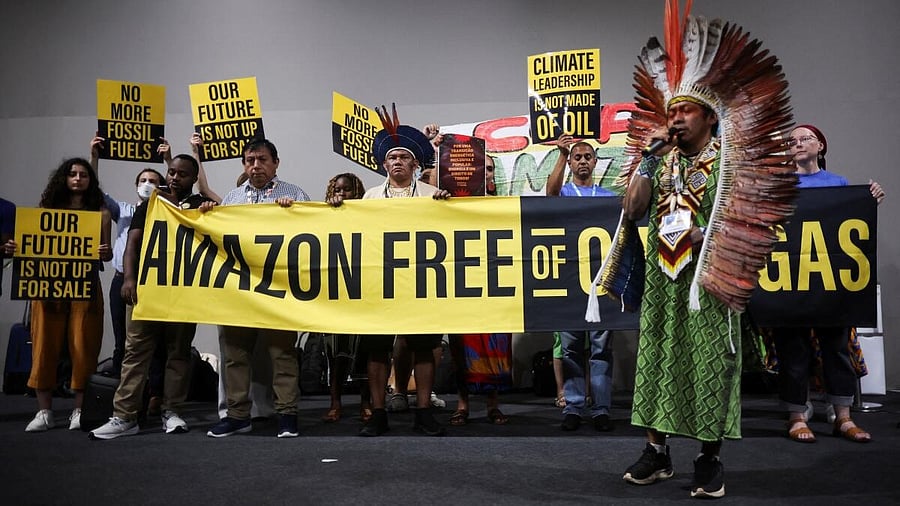
Activists and Indigenous people take part in a Stop EACOP campaign protest against fossil fuels during the UN Climate Change Conference (COP30) in Belem
Credit: Reuters Photo
By David Fickling
Another climate conference, another failed climate conference.
That’s the sense you might get from the anguished statements emerging at the close of the COP30 meeting in the Brazilian city of Belém at the weekend. Hopes that the final communiqué would incorporate a roadmap to transition away from fossil fuels were dashed. A planned $125 billion fund for forest protection ended up with just $6 billion or so committed.
That assessment confuses where we’re going wrong on climate, however — and what we’re getting right.
Take the weird refusal to mention fossil fuels in the agreement. That’s not quite the disaster it appears to be. Given the ability of oil exporters to veto every word of the text, it’s quite remarkable that such references ever made it through the drafting process. The fact that petroleum producers are now balking more aggressively at naming the problem we all face is a sign not of the failure of the energy transition, but of its success.
The International Energy Agency’s central expectation for fossil fuel consumption in 2050 has been cut by 12 per cent since the F-words were first officially mentioned at COP26 in Glasgow four years ago. Consumption of coal in the two biggest users, China and India, has fallen this year. These are far more substantive outcomes than the terminology of a United Nations document.
Credit: Bloomberg
That’s not to tell a triumphal story about the progress of climate policy in 2025 — only to say that the real problems are far away from the conference halls in Belém.
If you want to understand what we’re really doing wrong, look instead at an obscure page on a UN website where governments lodge their emissions-reduction plans, known as Nationally Determined Contributions, or NDCs. (Better still, go to Climate Action Tracker, a project that tries to translate these jargonistic documents into something approximating plain English.)
These NDCs are arguably the most important element of the Paris Agreement — the 2015 deal in which every country, for the first time, agreed to limit their greenhouse pollution. They’re meant to set clear, verifiable targets that can be measured against the best available science, and get progressively more ambitious over time. As we’ve written, there’s good evidence that governments which actually commit to such goals achieve them.
The latest list of plans, laying out where emissions will be in 2035, were intended to be a centerpiece of COP30. They fall far short of what is needed. Of the 10 biggest polluters accounting for three-quarters of carbon emissions, just two — the European Union and Japan — have submitted documents with any hope of being enacted. The Biden administration put in a US plan six weeks after President Donald Trump was elected, rendering the entire effort futile on delivery. India, Iran, Saudi Arabia and South Korea still haven’t come up with their proposals. China, Russia, and Indonesia have presented roadmaps so timid that they’d be able to increase their emissions substantially from current levels and still claim they hit the mark.
This lackluster effort is very in keeping with the tenor of politics in 2025. Whether they’re promising sanctions in retaliation for TV advertisements, threatening to behead a foreign leader, invading their neighbors, or bombing apartment blocks into rubble, the authoritarians in charge of the major powers don’t like to sign on to anything these days that constrains them.
It’s citizens who will ultimately decide the path of the future, though — and there, the picture is far brighter.
At times, they’re taking the energy transition into their own hands — whether it’s Pakistani households quitting a fossil-fired grid to use cheaper solar instead, or Turkish drivers switching to electric vehicles faster than Americans or Australians.
Credit: Bloomberg
At other times, they’re the ones responsible for implementing policies, delivering far more positive outcomes than their leaders would have you believe. (For all you might have read about phalanxes of gas turbines and coal plants being lined up to power America’s data-center explosion, some 10 months into the Trump administration, just 11 per cent of the generating capacity under construction is based on fossil fuels.) At still other times, they’re finding themselves in the path of the devastating effects of climate change itself.
Most of the technology we’ll need to solve this problem is already in our hands, and cheaper than the alternative, if only we’d remove the morass of barriers and regulation we’ve erected to slow its advance. Our problem is that the world’s leaders are some of the last to see that.
Plenty of people of all generations are aware of the benefits of action to halt climate change. But with an average age of 69, the headstrong leaders of the 10 big emitters have rarely had less of a stake in the state of things when the current crop of NDCs matures in 2035. Almost half the world’s population is younger than 30. It’s up to the rest of us to guide the world to a better course.
Disclaimer: The views expressed above are the author's own. They do not necessarily reflect the views of DH.